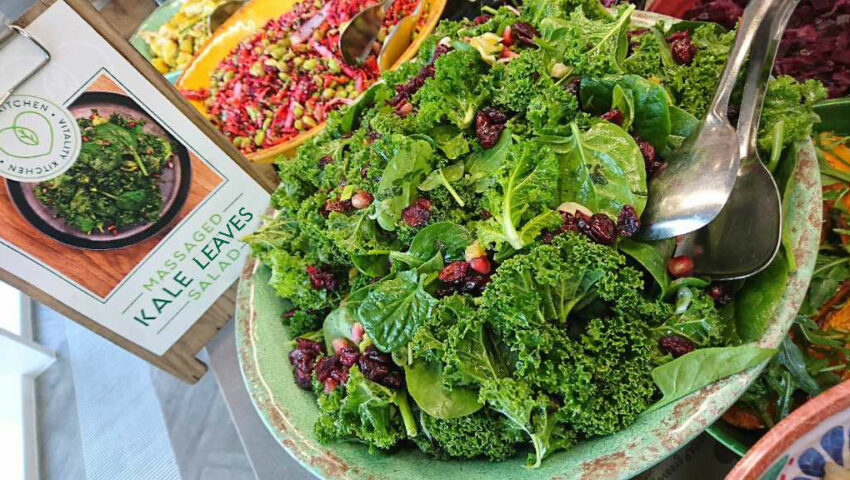Blogs
Top Tips to Enjoy Healthy Eating Week

This Healthy Eating Week we’re challenging you to banquet on butternut squash, munch more mangos, polish off the peas and generally eat more veg! We’ve all heard of 5 a day, but most of us are struggling to hit that target. So this week, we’re encouraging you to focus on small changes to rack up the numbers and hit 5 or more!
Where does 5-a-day come from?
Currently governmental guidelines encourage us to eat at least 5 portions of fruit and veg a day – just over a third of what we eat a day, illustrated in the Eatwell guide (1) is based on recommendations from the World Health Organization’s (WHO) research which concluded that consumption of more than 400g of fruit and veg was linked to reduced risk of death from chronic disease (2). So for us that means; 5 x 80g portions = 400g.
There’s confusion around this message however as around the globe there are a variety of different campaigns. France and Germany have adopted a similar 5-a-day message (3). Whereas in the USA the campaign, ‘fruit and veggies – more matters’ launched in 2007 (4), focuses on increasing consumption rather than setting a specific target. Canada released their new dietary guidelines in January 2019 (5). Their stance on fruit and veg has one of the simplest messages ‘have plenty of vegetables and fruit’, with accompanying plate showing fruit and veg taking up approximately half of the plate. In addition, the guidelines go beyond this and encourage a variety of habits alongside food choice which can contribute to healthy eating. This Includes being mindful of eating habits, cooking at home, and enjoyment of food, sharing food with others, wariness of food marketing and the use of food labels.
Although there seems to be a variety of different campaigns, what remains consistent is the emphasis on variety and increased consumption.
Does it work?
Dietary surveys in the UK capture our eating habits over a period of time. The latest release showed that only 31 % of men and 32% of women (65-74 year olds) are consuming the recommended ‘5 A Day’ (6). The question remains as to why this statistic is so low? Literature sources explore the reasoning behind this. They cite factors such as knowledge, price, time and cooking skills all as potential reasons.
Why is it so important?
As mentioned above the guideline for 5-a-day came from research which linked fruit and veg consumption with positive health outcomes. Fruit and veg not only taste great, are incredibly versatile, but also contain essential vitamins, minerals, phytochemicals and fibre which are all important to our health.
A variety of studies have illustrated that diets rich in a diverse range of fruit and veg have a lower risk of developing many diseases such some cancers (7), heart disease (8) and stroke (9). The overriding message is that the more fruit and veg a day the better.
Is there an optimal level?
Research published in 2017 (10) by a research team at UCL looked to re-examine the relationship between fruit and veg consumption and health. Using national survey data from 2001-2008 a total of 65,226 participants aged 35+ years were analysed to assess the relationship between fruit and veg consumption and health. Their analysis showed that those consuming more than 7 portions of fruit and veg a day had the lowest risk of death. Interestingly however, improvements were seen in those who consumed greater than three portions, compared to those who ate less than one. This paper also explored some possible barriers to consumption of fruit and veg which included:
- Difficulty changing habits
- Lack of time
- Cost
- Lack of motivation
- Eating what they were given
So what counts?
One portion of your 5 a day refers to:
Can count as more than one portion
- 80g of fresh, frozen or canned fruit or veg. It can come from one source or a variety eg 30g tomatoes, 20g celery, 15g cucumber and 15g of lettuce can make up an 80g portion.
- If choosing canned, opt for natural juice/water with no added sugar or salt.
- 30 g of dried fruit or veg
- Limit consumption due to the high sugar content
- Consume as part of a meal to reduce tooth damage
Only count as one portion
- 150ml of unsweetened 100% fruit/vegetable juice or 100% fruit and/or vegetable smoothies
- This will only ever count as one of your 5 a day. Compared to a whole fruit or veg a lot of the fibre is lost in processing. In addition sugars which are present within the fruit are released and are more available to damage teeth.
- 80 g of beans and pulses
- e.g haricot, butter soya and kidney beans as well as chickpeas and lentils
What doesn’t count?
Although they make up an important aspect of the diet, potatoes and other starchy ‘staples’ such as yam, cassava and plantain don’t count towards 5-a-day. However, they are a good source of energy, fibre, B Vitamins and potassium.
Other things that don’t count include:
- Fruit and veg with added fats, sugars or salt eg condiments such as ketchup.
- Nuts, seeds and coconut
- Marmalades and jams
- Fruit drinks with added ingredients (not water)
- Fruit & herb teas and other infusions
- Supplement type products, powdered concentrates, fruit and veg extracts
Best served raw? (11)
Nutrients contained within fruit and veg react differently to the effects of heat. Vitamins can be placed into two categories; water-soluble and fat-soluble. Fruit and veg tend to be higher in water-soluble vitamins, because of this cooking practices which involve water-emersion for long periods of time (eg boiling or blanching) incur the greatest amount of vitamin loss. Losses are also affected by the length of time something is heated. Therefore, cooking practices such as stir-frying and blanching help to reduce the heat degradation of vitamins – compared with longer cooking practices such as roasting. Equally, some vitamins are more sensitive than others – for example, vitamin C begins to degrade immediately after harvest, therefore, time from picking to purchasing is important (12). When it comes to minerals they also fall into two categories; essential and trace, essential being those that are required in high amounts, whilst trace are in smaller amounts. Minerals are less affected by cooking method than vitamins but tend to be lost through boiling where they’re leached into the water.
Overriding message
Regardless of the cooking process used, the contribution of all fruit and veg is important for many vitamins, minerals and fibre. The current UK government stance is the promotion of all types of fruit and veg; fresh, frozen and tinned.
Top Tips
- Seasonality is king– Fill your fruit bowl with seasonal fruit, this keeps it more interesting and is often better value for money and more tasty.
- Aim for the rainbow– a good variety of colours indicates a range of vitamins, minerals and fibre.
- Note what you prepare them with– fruit and veg themselves are low in calories so be mindful of what you prepare them with eg butter, cream or cheese sauces.
- Dried fruit– For extra fibre, nibble on dried fruit. Be mindful of damage they can do to your teeth and eat them alongside a meal.
- Bulk up– Add your veggies to stews, curries and casseroles. Try filling up more of the plate with veggies and less with meat. Or go all the way and try meat free Monday!
- Stock up– Tinned and frozen fruit and vegetables also count, stock up your freezer and store cupboards so you’re always prepared.
- Mash ‘Em– if you’re having mashed potato go 50/50 with sweet potato, turnips or swede.
- Swap– Start of small and try a simple veg swaps to get you started.
- Snack it– try slices of your favourite veg, handful of dried fruit for your mid-morning munch.
- Add it up –throw some veg into your favourite meals eg try adding spinach, tomatoes peas and broccoli to dishes such as mac n’ cheese and lasagne
- Sneak them in– grate your veg into casseroles, stews and sauces.
- Blend it– 150ml of unsweetened fruit/veg juice or smoothie counts as one portion – so try your favourite combinations.
- Bakeit- trade baked or roasted potatoes for other root veg
- Jazz it up– To your grains add peas and sweetcorn. Choose a frozen version and add them in with the cooking water halfway through.
- Breakfast Basics- Top of your breakfast with a portion of fruit or two. Winning combinations include; raisins, dried apricots, sliced banana, a handful of blueberries, strawberries or raspberries.
- Full – Filled– Add some extra veggies into sandwiches, wraps and rolls for lunchtimes.
- Topped Off– Peanut butter? Jam? Honey? Whatever your toast topping of choice add mashed avocado, banana or berries and yogurt to turn your slice of toast into a portion.
- Salading– Throw together pulses, seasonal veg and wholegrains all year round to get in the veg.
- Souped up – Create a bountiful vegetable soup with seasonal veg, beans and pulses.
- Prepare it – be super organised, roast a big tray of vegetables and keep in the fridge to add to salads, soups and sides.
References
- The Eatwell Guide. GOV.UK. 2016 [cited 13 May 2019]. Available from: https://www.gov.uk/government/publications/the-eatwell-guide
- World Health Organization. Diet, nutrition, and the prevention of chronic diseases. Geneva; 1990.
- Les fruits et légumes | Manger Bouger. Mangerbouger.fr. 2019 [cited 13 May 2019]. Available from: http://www.mangerbouger.fr/Les-recommandations/Augmenter/Les-fruits-et-legumes
- Have A Plant. Have A Plant. Fruits and Veggies for better health. 2019 [cited 13 May 2019]. Available from: https://fruitsandveggies.org/
- Canada’s Food Guide. Food-guide.canada.ca. 2019 [cited 13 May 2019]. Available from: https://food-guide.canada.ca/en/?utm_source=canada-ca-foodguide-en&utm_medium=vurl&utm_campaign=foodguide
- Public Health England / Food Standards Agency. National Diet and Nutrition Survey: Results from Years 7 and 8 (combined) of the Rolling Programme (2014/2015 to 2015/2016). London: PHE Publications; 2018.
- World Cancer Research Fund / American Institute for Cancer Research. Food, Nutrition, Physical Activity, and the Prevention of Cancer: a Global Perspective. Washington DC: American institute for Cancer Research; 2007.
- He F, Nowson C, Lucas M, MacGregor G. Increased consumption of fruit and vegetables is related to a reduced risk of coronary heart disease: meta-analysis of cohort studies. Journal of Human Hypertension. 2007;21(9):717-728.
- He F, Nowson C, MacGregor G. Fruit and vegetable consumption and stroke: meta-analysis of cohort studies. The Lancet. 2006;367(9507):320-326.
- Oyebode O, Gordon-Dseagu V, Walker A, Mindell J. Fruit and vegetable consumption and all-cause, cancer and CVD mortality: analysis of Health Survey for England data. Journal of Epidemiology and Community Health. 2014;68(9):856-862.
- More than fresh – vegetable choices for everyone: (EUFIC). Eufic.org. 2019 [cited 13 May 2019]. Available from: https://www.eufic.org/en/healthy-living/article/more-than-fresh-vegetable-choices-for-everyone
- Rickman J, Barrett D, Bruhn C. Nutritional comparison of fresh, frozen and canned fruits and vegetables. Part 1. Vitamins C and B and phenolic compounds. Journal of the Science of Food and Agriculture. 2007;87(6):930-944.




